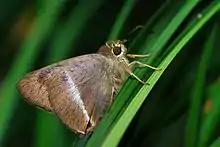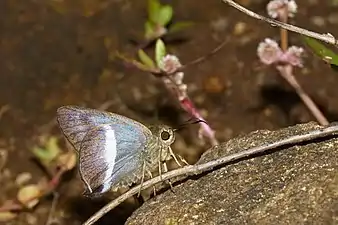Hasora taminatus
Hasora taminatus,[2][3] the white banded awl,[4] is a butterfly belonging to the family Hesperiidae, which is found in Asia.[5][6]
| White banded awl | |
|---|---|
 | |
| Hasora taminatus vairacana | |
| Scientific classification | |
| Domain: | Eukaryota |
| Kingdom: | Animalia |
| Phylum: | Arthropoda |
| Class: | Insecta |
| Order: | Lepidoptera |
| Family: | Hesperiidae |
| Genus: | Hasora |
| Species: | H. taminatus |
| Binomial name | |
| Hasora taminatus | |
| Synonyms | |
| |
Range
The butterfly is found in Sri Lanka, India, Myanmar, Cambodia Thailand, Laos, Hainan, Hong Kong, western China, Malaysia, the Indonesian archipelago (Borneo, Sumatra, Java, Nias, Sumbawa and Bali), the Philippines and Sulawesi.
In India the butterfly is found in South India, where it occurs in the Western Ghats, Kodagu, Nilgiri mountains and Palni hills; and in the Himalayas from Mussoorie eastwards to Sikkim and through to Myanmar. It is also found in the Andaman and Nicobar islands.[4][3][7]
The type locality is South India.[3]

Status
William Harry Evans (1932) reports that it is common in South India and not rare elsewhere.[7]
Description
The butterfly, which has a wingspan of 45 to 55 mm, is dark brown and unmarked above; and resembles the common banded awl (Hasora chromus), except that it has a broad white band on the under hindwing which is sharply defined. The female white banded awl has small spots on the upper forewing while the male has no brand above.[8][9]
Detailed description
Edward Yerbury Watson (1891) gives detailed descriptions of H. t. malayana (C. & R. Felder, 1860), shown below:[10]
Alls supra fuscis, subtus anticarum limbo costali, posticarum dimidio basali chalybaeis, his striga discali alba.
— (Felder, I. c.)
The females have a small semi-transparent yellowish discal speck between the two posterior branches of the median vein, and of course lack the oblique band of short lines of modified scales seen in the males of this as well as of the preceding closely-allied species." (Wood-Mason and de Niceville, J. A. S. B., 1881, p. 254.)
The above refers to Andaman females only, as in the Nicobar females the small semi-transparent yellow discal speck between the two posterior branches of the median vein is wanting according to Messrs. Wood-Mason and de Niceville.
Recorded from the Andamans and Nicobars.
Note: As H. t. malayana is sympatric with another subspecies, H. t. bhavara Fruhstorfer, 1911 in part of its range it has now been given specific status.
Host plants
The larva has been recorded on Derris scandens and Pongamia pinnatta species.[3][11]
Subspecies
- Hasora taminatus taminatus
- Hasora taminatus vairacana Fruhstorfer, 1911 (Taiwan, Japan)
- Hasora taminatus bhavara Fruhstorfer, 1911 (Sikkim)
- Hasora taminatus padma Fruhstorfer, 1911 (Palawan)
- Hasora taminatus malayana (C. & R. Felder, 1860) (Sikkim to Burma, Thailand, Laos, Hainan, Hong Kong, West China, Malaya, Borneo, Sumatra, Java, Nias, Sumbawa, Bali)
- Hasora taminatus attenuata (Staudinger, 1889) (Sulawesi)
- Hasora taminatus amboinensis Swinhoe, 1909 (New Guinea)
Cited references
- Beccaloni, G.; Scoble, M.; Kitching, I.; Simonsen, T.; Robinson, G.; Pitkin, B.; Hine, A.; Lyal, C., eds. (2003). "Hasora taminatus". The Global Lepidoptera Names Index. Natural History Museum. Retrieved April 20, 2018.
- TOL web page on genus Hasora Archived 2020-10-14 at the Wayback Machine
- Markku Savela's website on Lepidoptera - page on genus Hasora.
- R.K., Varshney; Smetacek, Peter (2015). A Synoptic Catalogue of the Butterflies of India. New Delhi: Butterfly Research Centre, Bhimtal & Indinov Publishing, New Delhi. p. 25. doi:10.13140/RG.2.1.3966.2164. ISBN 978-81-929826-4-9.
- W. H., Evans (1949). A Catalogue of the Hesperiidae from Europe, Asia, and Australia in the British Museum. London: British Museum (Natural History). Department of Entomology. p. 61.
-
 One or more of the preceding sentences incorporates text from this source, which is in the public domain: Swinhoe, Charles (1911–1912). Lepidoptera Indica. Vol. IX. London: Lovell Reeve and Co. p. 253.
One or more of the preceding sentences incorporates text from this source, which is in the public domain: Swinhoe, Charles (1911–1912). Lepidoptera Indica. Vol. IX. London: Lovell Reeve and Co. p. 253. - Evans, W.H. (1932). The Identification of Indian Butterflies (2nd ed.). Mumbai, India: Bombay Natural History Society. p. 316, ser no I1.15.
- Wynter-Blyth, Mark Alexander (1957). Butterflies of the Indian Region. Bombay, India: Bombay Natural History Society. p. 468. ISBN 978-8170192329.
- Kunte, Krushnamegh (2000). Butterflies of Peninsular India. India, A Lifescape. Hyderabad, India: Universities Press. p. 192. ISBN 978-8173713545.
-
 One or more of the preceding sentences incorporates text from this source, which is in the public domain: E. Y., Watson (1891). Hesperiidae Indicae : being a reprint of descriptions of the Hesperiidae of India, Burma, and Ceylon. Madras: Vest and Company. p. 18. (under Parata malayana Felder).
One or more of the preceding sentences incorporates text from this source, which is in the public domain: E. Y., Watson (1891). Hesperiidae Indicae : being a reprint of descriptions of the Hesperiidae of India, Burma, and Ceylon. Madras: Vest and Company. p. 18. (under Parata malayana Felder). - Ravikanthachari Nitin; V.C. Balakrishnan; Paresh V. Churi; S. Kalesh; Satya Prakash; Krushnamegh Kunte (2018-04-10). "Larval host plants of the buterfies of the Western Ghats, India". Journal of Threatened Taxa. 10 (4): 11495–11550. doi:10.11609/jott.3104.10.4.11495-11550 – via JoTT.
References
Print
- Evans, W.H. (1932). The Identification of Indian Butterflies (2nd ed.). Mumbai, India: Bombay Natural History Society.
- Kunte, Krushnamegh (2000). Butterflies of Peninsular India. India, A Lifescape. Hyderabad, India: Universities Press. ISBN 978-8173713545.
- Watson, E. Y. (1891) Hesperiidae indicae. Vest and Co. Madras.
- Wynter-Blyth, Mark Alexander (1957). Butterflies of the Indian Region. Bombay, India: Bombay Natural History Society. ISBN 978-8170192329.
Online
- Beccaloni, George; Scoble, Malcolm; Kitching, Ian; Simonsen, Thomas; Robinson, Gaden; Pitkin, Brian; Hine, Adrian; Lyal, Chris. "The Global Lepidoptera Names Index (LepIndex)". Natural History Museum, London. Retrieved 2016-10-15.
- Brower, Andrew V. Z., (2007). Hasora Moore 1881. Version 21 February 2007 (under construction). Page on genus Hasora in The Tree of Life Web Project http://tolweb.org/.
- "Markku Savela's website on Lepidoptera".